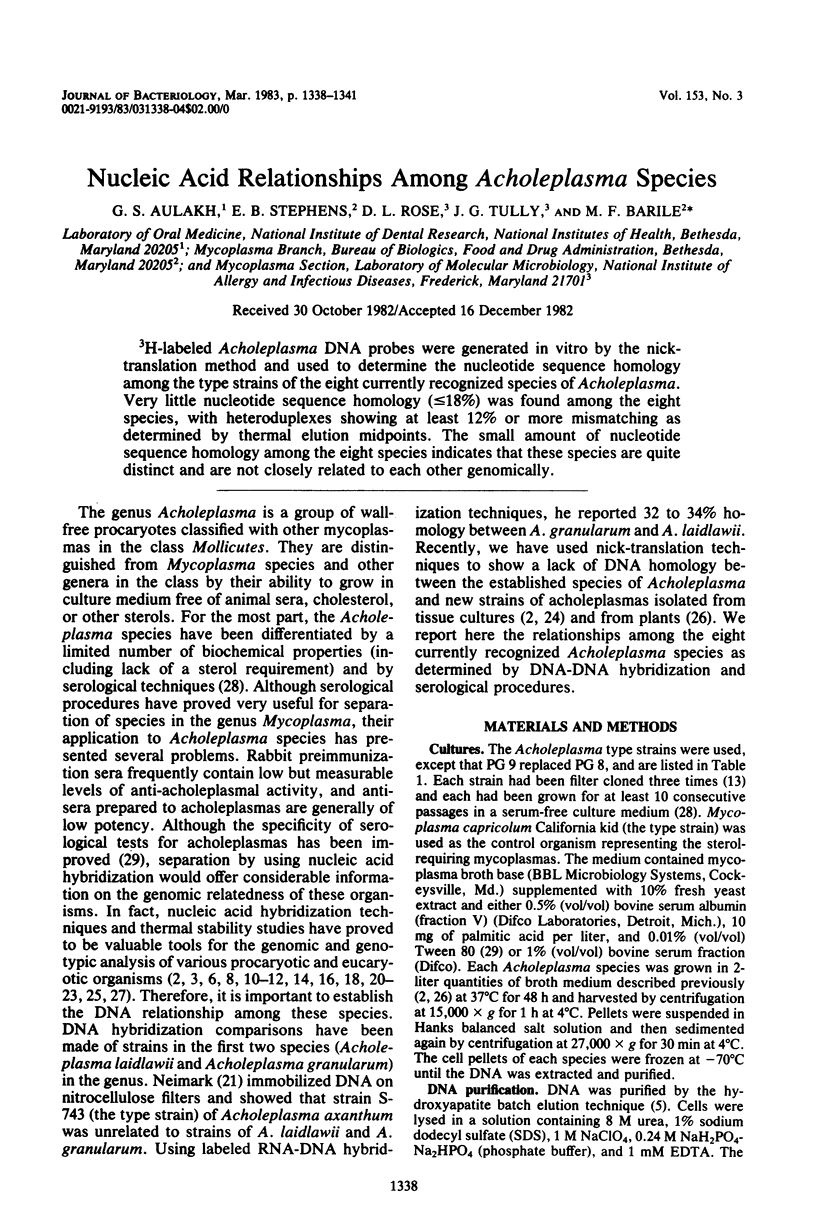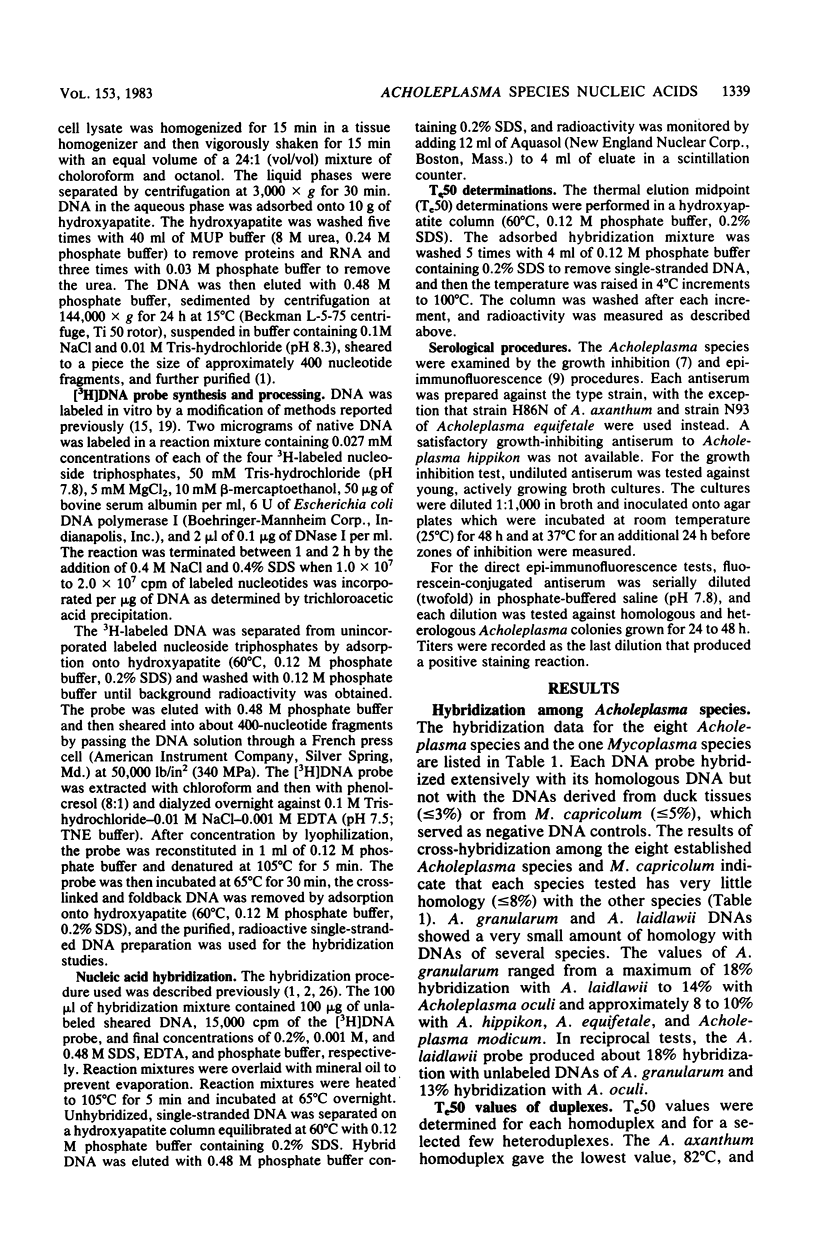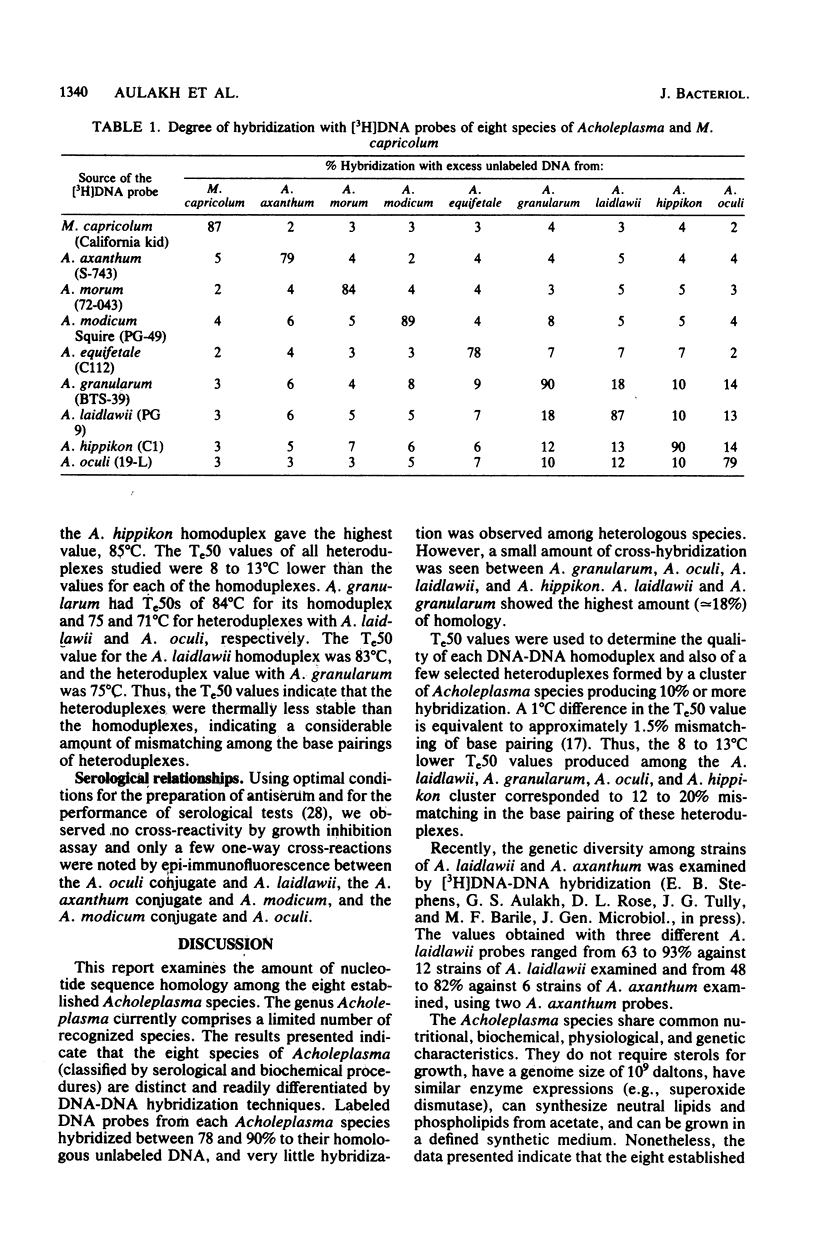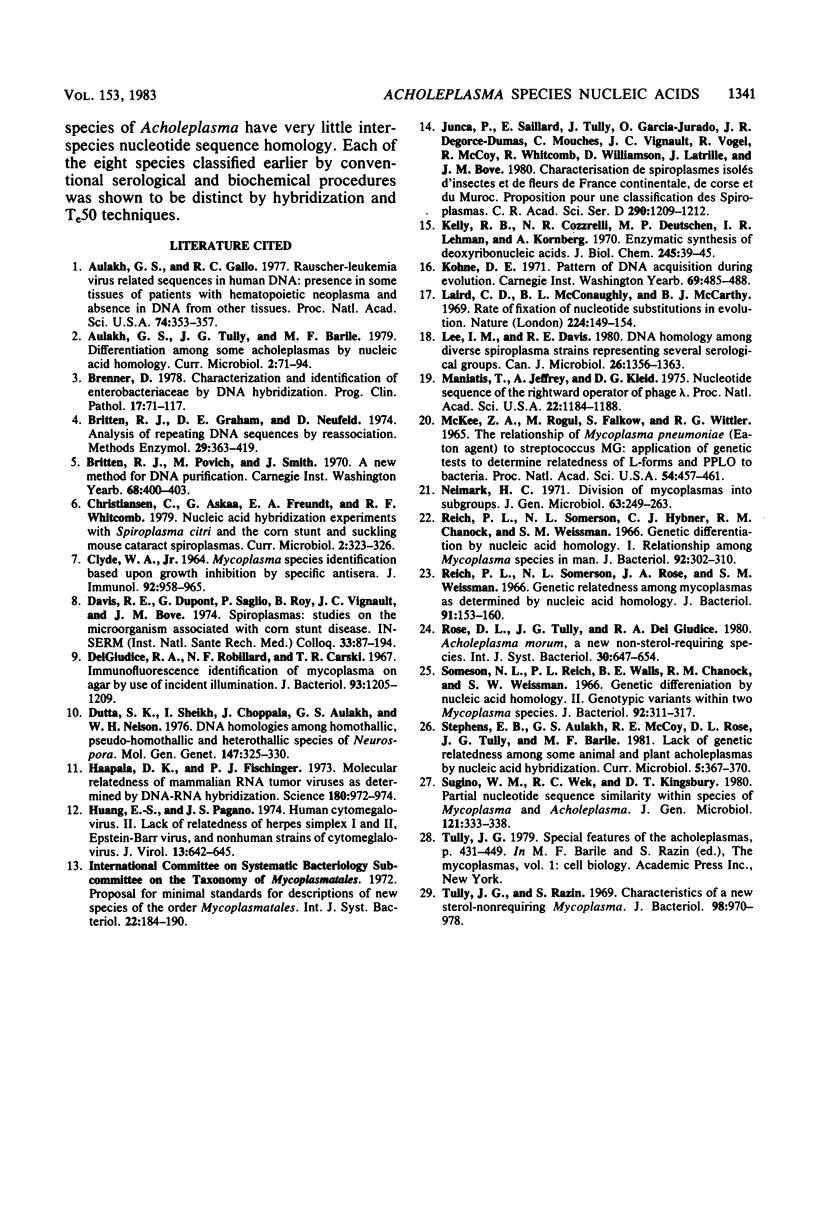Abstract
3H-labeled Acholeplasma DNA probes were generated in vitro by the nick-translation method and used to determine the nucleotide sequence homology among the type strains of the eight currently recognized species of Acholeplasma. Very little nucleotide sequence homology (less than or equal to 18%) was found among the eight species, with heteroduplexes showing at least 12% or more mismatching as determined by thermal elution midpoints. The small amount of nucleotide sequence homology among the eight species indicates that these species are quite distinct and are not closely related to each other genomically.
Full text
PDF



Selected References
These references are in PubMed. This may not be the complete list of references from this article.
- Aulakh G. S., Gallo R. C. Rauscher-leukemia-virus-related sequences in human DNA: presence in some tissues of some patients with hemotopoietic neoplasias and absence in DNA from other tissues. Proc Natl Acad Sci U S A. 1977 Jan;74(1):353–357. doi: 10.1073/pnas.74.1.353. [DOI] [PMC free article] [PubMed] [Google Scholar]
- Brenner D. J. Characterization and clinical identification of Enterobacteriaceae by DNA hybridization. Prog Clin Pathol. 1978;7:71–117. [PubMed] [Google Scholar]
- Britten R. J., Graham D. E., Neufeld B. R. Analysis of repeating DNA sequences by reassociation. Methods Enzymol. 1974;29:363–418. doi: 10.1016/0076-6879(74)29033-5. [DOI] [PubMed] [Google Scholar]
- CLYDE W. A., Jr MYCOPLASMA SPECIES IDENTIFICATION BASED UPON GROWTH INHIBITION BY SPECIFIC ANTISERA. J Immunol. 1964 Jun;92:958–965. [PubMed] [Google Scholar]
- Del Giudice R. A., Robillard N. F., Carski T. R. Immunofluorescence identification of Mycoplasma on agar by use of incident illumination. J Bacteriol. 1967 Apr;93(4):1205–1209. doi: 10.1128/jb.93.4.1205-1209.1967. [DOI] [PMC free article] [PubMed] [Google Scholar]
- Dutta S. K., Sheikh I., Choppala J., Aulakh G. S., Nelson W. H. DNA homologies among homothallic, pseudo-homothallic and heterothallic species of Neurospora. Mol Gen Genet. 1976 Sep 23;147(3):325–330. doi: 10.1007/BF00582884. [DOI] [PubMed] [Google Scholar]
- Haapala D. K., Fischinger P. J. Molecular relatedness of mammalian RNA tumor viruses as determined by DNA hybridization. Science. 1973 Jun 1;180(4089):972–974. doi: 10.1126/science.180.4089.972. [DOI] [PubMed] [Google Scholar]
- Huang E. S., Pagano J. S. Human cytomegalovirus. II. Lack of relatedness to DNA of herpes simples I and II, Epstein-Barr virus, and nonhuman strains of cytomegalovirus. J Virol. 1974 Mar;13(3):642–645. doi: 10.1128/jvi.13.3.642-645.1974. [DOI] [PMC free article] [PubMed] [Google Scholar]
- Kelly R. B., Cozzarelli N. R., Deutscher M. P., Lehman I. R., Kornberg A. Enzymatic synthesis of deoxyribonucleic acid. XXXII. Replication of duplex deoxyribonucleic acid by polymerase at a single strand break. J Biol Chem. 1970 Jan 10;245(1):39–45. [PubMed] [Google Scholar]
- Laird C. D., McConaughy B. L., McCarthy B. J. Rate of fixation of nucleotide substitutions in evolution. Nature. 1969 Oct 11;224(5215):149–154. doi: 10.1038/224149a0. [DOI] [PubMed] [Google Scholar]
- Lee I. M., Davis R. E. DNA homology among diverse spiroplasma strains representing several serological groups. Can J Microbiol. 1980 Nov;26(11):1356–1363. doi: 10.1139/m80-224. [DOI] [PubMed] [Google Scholar]
- Maniatis T., Jeffrey A., Kleid D. G. Nucleotide sequence of the rightward operator of phage lambda. Proc Natl Acad Sci U S A. 1975 Mar;72(3):1184–1188. doi: 10.1073/pnas.72.3.1184. [DOI] [PMC free article] [PubMed] [Google Scholar]
- McGee Z. A., Rogul M., Falkow S., Wittler R. G. The relationship of Mycoplasma pneumoniae (Eaton agent) to Streptococcus MG: application of genetic tests to determine relatedness of L-forms and PPLO to bacteria. Proc Natl Acad Sci U S A. 1965 Aug;54(2):457–461. doi: 10.1073/pnas.54.2.457. [DOI] [PMC free article] [PubMed] [Google Scholar]
- Reich P. R., Somerson N. L., Hybner C. J., Chanock R. M., Weissman S. M. Genetic differentiation by nucleic Acid homology I. Relationships among Mycoplasma species of man. J Bacteriol. 1966 Aug;92(2):302–310. doi: 10.1128/jb.92.2.302-310.1966. [DOI] [PMC free article] [PubMed] [Google Scholar]
- Reich P. R., Somerson N. L., Rose J. A., Weissman S. M. Genetic relatedness among mycoplasmas as determined by nucleic acid homology. J Bacteriol. 1966 Jan;91(1):153–160. doi: 10.1128/jb.91.1.153-160.1966. [DOI] [PMC free article] [PubMed] [Google Scholar]
- Somerson N. L., Reich P. R., Walls B. E., Chanock R. M., Weissman S. M. Genetic Differentiation by Nucleic Acid Homology II. Genotypic Variations Within Two Mycoplasma Species. J Bacteriol. 1966 Aug;92(2):311–317. doi: 10.1128/jb.92.2.311-317.1966. [DOI] [PMC free article] [PubMed] [Google Scholar]
- Sugino W. M., Wek R. C., Kingsbury D. T. Partial nucleotide sequence similarity within species of Mycoplasma and Acholeplasma. J Gen Microbiol. 1980 Dec;121(2):333–338. doi: 10.1099/00221287-121-2-333. [DOI] [PubMed] [Google Scholar]
- Tully J. G., Razin S. Characteristics of a new sterol-nonrequiring Mycoplasma. J Bacteriol. 1969 Jun;98(3):970–978. doi: 10.1128/jb.98.3.970-978.1969. [DOI] [PMC free article] [PubMed] [Google Scholar]


